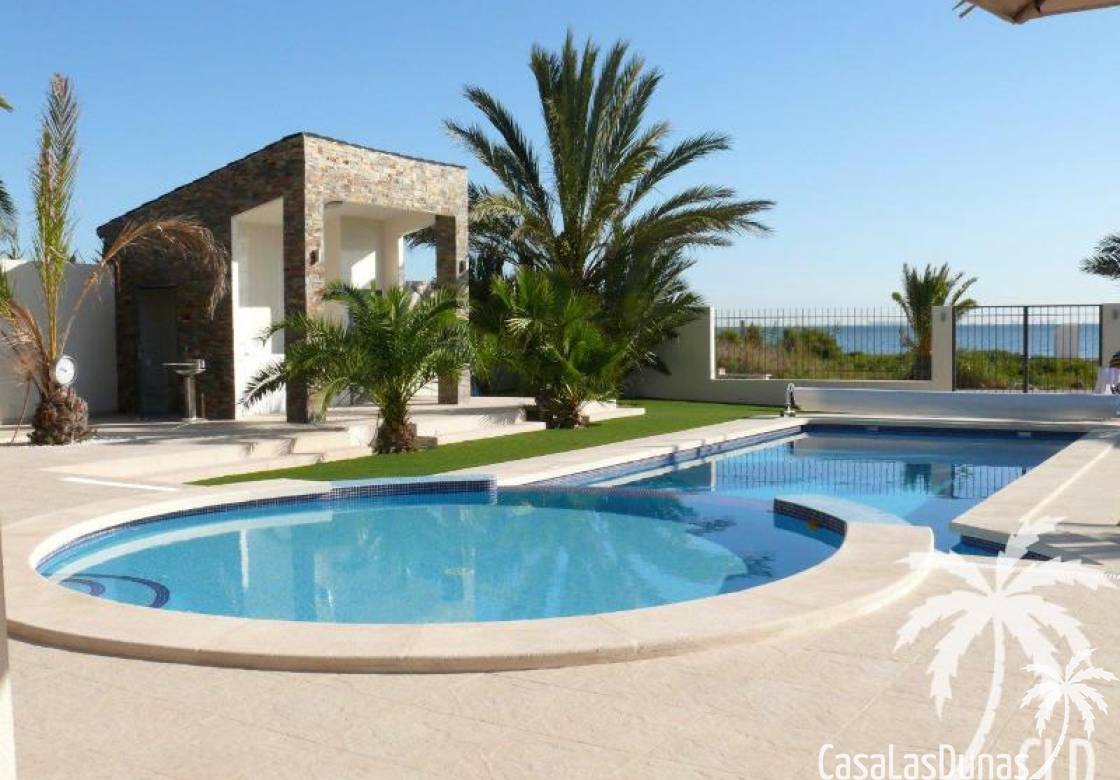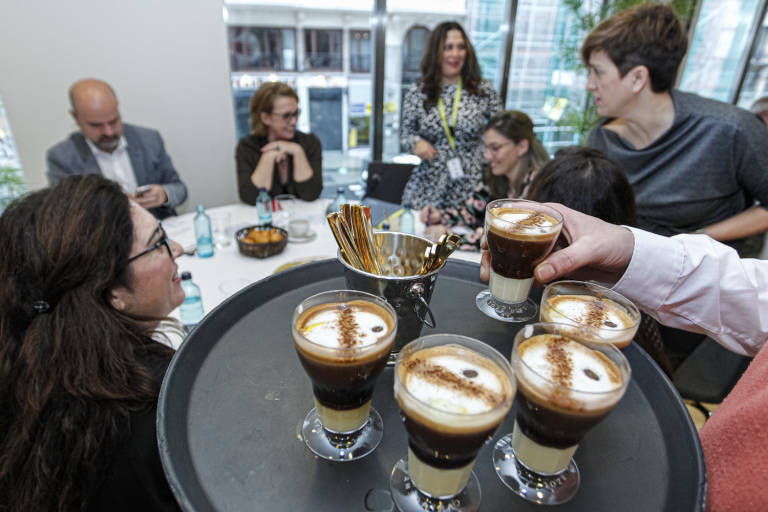
If there is one region that is unknown to Dutch tourists, it is the region of Murcia. That has its advantages. You can still fully immerse yourself in Spanish life. A disadvantage: you will not easily learn good Spanish there, because they chew off a lot. The big advantages: still beautiful pristine beaches, no hordes of tourists and a big surprise: the port city of Cartagena.
The Costa Cálida, the coastal strip of the Murcia region, is not called the 'warm coast' for nothing. The sun shines here for more than 300 days a year and with a bit of luck you can even have lunch on a terrace at the end of December. However, this region is still quite unknown. We hear more and more often that it is completely unjustified. There are hidden beaches that are not inferior to the coves of Cabo de Gata. You can walk endlessly in protected nature parks and the big plus: foreign tourism has barely got off the ground.
Holiday Villages
We decide to put it to the test and settle in one of the many resorts that have arisen between the coast and the city of Murcia. They are huge holiday villages with luxury houses and simple apartments, swimming pools, golf courses, a supermarket, restaurants and other entertainment. In the summer it is teeming with holidaymakers, but in the winter months and early spring you have the kingdom almost to yourself. At first it seems a bit strange, these holiday villages in a landscape full of greenhouses, but later we hear the reason: it is no longer allowed to build on the coastline, and if you have to take the car anyway, you can might as well go a little further inland. This policy represents a huge improvement, as it protects the coastline from previous excesses, towering hotels that you see in the Murcia region, for example, on the Mar Menor.
Sunday market
We drive on a Sunday morning towards the inland sea Mar Menor to visit the market of Cabo de Palos. When we arrive, a Dalian surreal landscape unfolds before our eyes. The sun reflects off the lake in which two islands rise, a beautiful sight that is rudely disturbed by the ugly towering buildings around it. Our Murcian friend Juan told us not to miss the Cabo de Palos market. And a market in the coastal village on an early Sunday morning does indeed seem appealing, but there is little to see of the sea on the market. In a remote corner of the village the market people have displayed their wares. It is more reminiscent of a market in former communist Yugoslavia than a cozy Mediterranean mercado. But that too has its charm. If, like us, you are not in the high season, it is especially nice that you will not find any tourists. Here the Murcianos buy their T-shirts, dresses and vegetables that come straight from the fertile hinterland. Bargain hunters can score three pairs of socks for two euros and a scarf can be bought for one euro. On a desolate square in the middle, two South American panflute players provide some atmosphere and the good coffee for a euro does the rest. We ignore the tip to stay and eat here. We are looking for a piece of authentic Murcia.
Pristine beaches, spoiled nature
Because if the region of Murcia has one big asset, it is the beautiful beaches that can usually only be reached on foot and are therefore still unspoilt. In total, the coastline extends over 250 kilometers. Just around the corner from the touristic Mar Menor is such a beach in a protected nature reserve. When we turn into a side road towards Calblanque, the landscape changes immediately and it seems as if we are driving through the wasteland of Cabo de Gata further south. Dwarf palms, cacti and agaves cover the hills. The good asphalt road leads to the information center where a friendly employee tells about the walking routes that run through the park. We have little time and just want an hour to the beach that is a little further. Except for a few horsemen and a lost hiker, the beach enclosed by mountains is deserted. What a wonderful discovery! And to think that the entire coastline is dotted with these kinds of beaches. But they are not easy to find. We take another shortcut towards Cartagena and the landscape that we then encounter starts off sweetly, until we arrive in Portman and La Unión, two mining towns where the nature has been roughly disturbed by miners who were mainly looking for silver. Portman's old town has turned into a ghost town, but La Unión is still a lively town famous for the Cante de las Minas, the most prestigious Flamenco festival in the world.
Spanish Wirtschaftswunder
Just after noon we arrive in Cartagena. According to Juan an ugly naval city surrounded by petrochemical industry that is not really worth a visit. Yet we are very curious about this former stronghold of the Romans, the Punics and the Moors. To our surprise, the shops are open on Sunday afternoons in the main street, Calle Mayor. It soon becomes apparent that Juan has completely missed the point. Cartagena is the textbook example of the Spanish Wirtschaftswunder. Here you see that the Spaniards have not only wasted the European Union's money on building useless highways, but also that in-depth investments have been made in preserving heritage and creating new cultural centers. The car-free shopping street has been beautifully renovated and houses a few fantastic modernist buildings that are beautifully combined with stylish new construction. We walk around and come to a gigalift that takes us up for two euros where an old fortress has been transformed into a museum that has mapped the history of the city. From the mountain you have a phenomenal view of one of the other highlights: the Roman amphitheater that has been beautifully restored in recent years.
Smart example of urban planning
That Cartagena is following the example of Bilbao and Valencia is a clever example of urban planning is apparent from the way in which the heritage has been refurbished and is presented. The aim is to give the economy a swing by attracting more tourists. And the naval city makes good use of the direct location of the city center on the harbor. It is not for nothing that the shops here are open on Sundays. This is mainly because of the cruise ships that can dock here almost directly on Calle Mayor. To make it easy for the tourist, the Cartageners have also realized two beautiful projects directly on the quay in recent years: El Batel, an auditorium, congress center and exhibition space is a futuristic building in white and orange that you can also visit if you don't attend a conference or concert. The pleasant, sleek terrace serves a nice solo and offers a view of the harbour. However, if possible, try to book a concert so that you can admire the beautiful concert hall from the inside. Right next door is the ARQVA, the Museo Nacional de Arqueología Subacuática, where a beautiful exhibition about marine life has been set up.
Strong coffee
From the quay we walk back to the main street where the shops are still open and the slipper parade has started. Fortunately, we can just go there during Dutch times for a nice tapas meal and see the population pass by while chatting. Our terrace neighbors are sipping a special coffee, the white at the top is black at the bottom, we would like to try that too. According to the waiter, it is a café asiatico, one of the specialties of the region: condensed milk at the bottom, followed by a strong solo and two generous splashes of Licor 43 and brandy. The next day it's Monday and the museums are closed, too bad, otherwise we would have definitely stayed to discover even more of Cartagena. But we also want to see the city of Murcia.
Moorish Murcia
Murcia was founded in the ninth century by the Emir of Córdoba on a fertile plain by the River Segura. The Moorish influence is still noticeable in the city, not only in the pieces of architecture and Moorish walls, but mainly because of the remains of the complex irrigation system that they built here to use the water from the river to the last drop to irrigate the the fields. Archaeologists have found remains of a mosque in the heart of the city, near the cathedral. Some of their finds can now be seen in the exhibition space at the church. Also in other parts of the city we see former fortifications and the remains of irrigation systems. The showpiece is the Monastery of Santa Clara La Real, with a beautiful patio with water features and flower beds. But the Murcians don't really care about this heritage. They especially love one thing: eating tapas with friends in one of the hundreds of bars and restaurants in the lively student city. The Plaza Flores and Plaza San Juan are the epicenter. We were invited by friends to Pepe el Torrao de San Juan. The house specialty: locally brewed beer and gambas in a jacket. 'A secret recipe that has been in the family since 1964', says the waiter. It tastes better to us than the mojama and other dried fish served all over the region. This is followed by the local variation on the Valencian paella: arroz murciano, accompanied by a delicious glass of wine from the nearby Jumilla wine region. Unfortunately, our time is up. We would have liked to visit some bodegas in Jumilla and Yecla or drove a nice route through one of the mountain areas in the area. Murcia has convinced us and leaves us wanting more!
Source: espanje.nl














